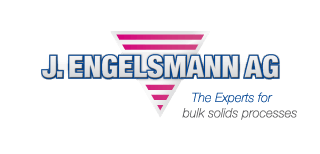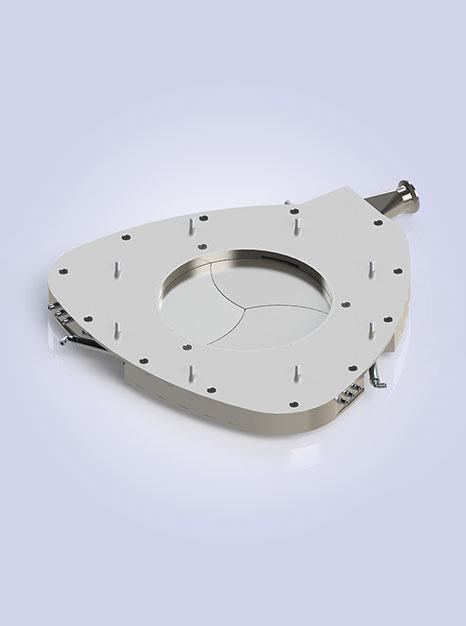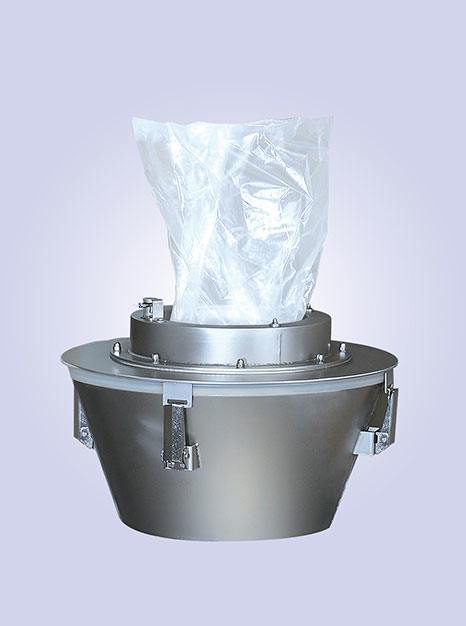Attaching big bags: Filling and emptying big bags without dust
They are easy to handle logistically and offer a big volume: big bags. These flexible intermediate bulk containers are enormously popular for packaging bulk solids for transport and storage at low cost and low environmental impact. Different bulk solids, however, have different compositions and properties, and a common problem is achieving dust-free and metered filling or dosing from a big bag. Flexible handling requires high performance connecting and dosing systems if big bags are to be filled, dosed and emptied dust-free.
Filling and emptying big bags with bulk solids is hardly a trivial process: While manually docking the container, foreign substances such as dirt or dust can get into the open system via the operating personnel or from the environment. Other problems arise during partial emptying of containers and subsequent removal of the partially emptied big bags. These challenges are only further compounded by the many different types of big bag in circulation. Many companies namely receive their raw materials from multiple suppliers, or supply their customers with big bags featuring inlet or outlet nozzles of different lengths or diameters. This can cause difficulties when connecting the big bags to the filling unit, and necessitate costly and time-consuming adaptation work. Easy, dust-proof docking of the big bag demands reliable, user-friendly connection systems that can be adjusted to suit different needs.
One connection system for a variety of big bag sizes
With the JEL SafeConnect system, bulk solids technology specialist J. Engelsmann AG has developed a flexible connection solution to accommodate big bags with inlet and outlet nozzles of differing lengths. Using JEL SafeConnect eliminates the need for laborious adjustments to different lengths of big bag nozzle. Connections can be made easily within a tolerance of 50 mm. The system can be used with different inlet and outlet nozzle diameters (250 to 400 mm) without retrofitting, as can be seen from a case example: A supplier in the plastics processing industry had always used the same size of big bags for filling his granulate. A new customer of the plastics manufacturer, however, needed big bags with an inlet nozzle of larger diameter. In order to fill these larger big bags, the manufacturer had to make costly modifications to the filling head of his filling unit. As further customer requests came in for using different and even proprietary big bags, the plastics supplier had to find a solution that would provide the necessary tolerance for the inlet nozzle diameter. With the JEL SafeConnect, the supplier can now meet the various customer needs without having to make any time-consuming adaptations to his filling unit.
Reduce retrofitting times when changing big bags
The JEL SafeConnect system connects easily onto existing big bag systems and transfer points within certain tolerances without retrofitting. A leading producer in the chemicals industry, for example, already had a conventional connection system for emptying big bags in his production process. Every time the big bags were changed, however, a great deal of time had to be spent adapting the system, resulting in costly downtimes. After introducing the easily adaptable JEL SafeConnect, the company was able to significantly shorten the retrofitting times for these big bag changes, and plant productivity increased accordingly.
The compact design of the Engelsmann solution lends itself especially to limited-space situations. In another case example, a fertilizer producer had to move a big bag emptying frame to a new location with a lower ceiling. Instead of shortening the entire emptying unit at great cost, the far less expensive solution was to introduce the JEL SafeConnect system with its low installation height.
Safety first
Irrespective of the type of connector system used, the safety of the operator and the environment takes highest priority when filling and emptying big bags. The principle of the standard model of the JEL SafeConnect system uses a pneumatic seal to allow dust-proof docking of big bags. The big bag filled with bulk solids is introduced into the filling or emptying station and positioned beneath or above the connector system. The nozzle of the big bag is pulled over a flexible adapter ring, inserted into the housing of the JEL SafeConnect adapter and connected to it. Compressed air is then fed in to inflate the integrated pneumatic seal, fastening the big bag nozzle for a dust-proof connection. An optional suction unit and shut-off valve prevent pollution of the environment and corresponding control technology protects the operator from any dangers.
For all users and situations without a compressed air connection, a sophisticated version of the standard system makes a mechanical connection to firmly fasten the inlet or outlet nozzle of the big bag to the system. By simply operating two levers, a metal ring clamps the big bag nozzle to make a secure connection.
Additionally, an add-on module for the connection system, named JEL Protect, protects the downstream processes and plants against contamination from dirt and foreign bodies during emptying of the big bag. The stainless steel add-on component comprises a locking plate, a pre-chamber above it and a suction unit. When using JEL protect, the add-on module is flanged under the JEL SafeConnect system with closed lock plate and the big bag outlet nozzle connected to the connector system. In order to remove any debris such as wood chips or other foreign bodies that may have gathered beneath the outlet nozzle while transporting the big bag, the pre-chamber of the add-on module is flushed with air. After flushing, the lock plate is opened and the tie cord of the big bag loosened in order to start the emptying. Once the big bag is fully empty, the lock plate of the JEL Protect module is closed again to prevent contamination of the downstream bulk solids process
Trickle protection ensures uncontaminated filling
Alongside the dust-proof and secure connection of big bags, dosing during the filling/emptying process is another task that must be performed as precisely and contamination-free for man and environment as possible. The JEL FlowStop trickle-protection system is a multifunctional solution that protects against contamination from residual trickles of product and serves as a dosing unit as well. This trickle protection can be used in any type of plant for dry, pourable bulk solids in all areas of the chemical, plastics, pharmaceutical, food and related industries. The stainless steel components comprise a two-piece protection flap that closes during or at the end of the filling process. This prevents residual trickling of the product from the feed tube and protects the operating personnel and downstream plant components against any contamination from the product. Equipped with optional position controls, the JEL FlowStop system can also be used as a stepless dosing unit in addition to its protective function. Flexible positioning of the metering valve avoids heap formation during the filling process and optimally uses the fill volume of the big bag. Upon request, the optionally pneumatically or manually operated trickle protection can also be supplied as a clean-in-place (CiP) model and can be retrofitted with tri-clamp nozzles and/or an aspiration connection, irrespective of the type of plant in use.









